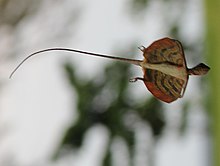glide
Gliding is any type of flight in which only positional energy is used as an energy source for lift and propulsion . Birds glide when they are not flapping their wings; Aircraft are gliding when they are not using any technical drive .
The observation of the gliding flight in birds and the adoption of the principles recognized thereby z. B. in the profiling for wings preceded the construction of the first successful man-carrying gliders from Lilienthal from 1891. With other gliding animals and winged flying seeds, nature provides numerous other models for gliding.
Gliding is used by all non-motorized aircraft that are heavier than air , such as gliders , hang-gliders and paragliders . Airplanes specially designed for gliding are called gliding planes , and in principle every aircraft is capable of gliding. For example, a commercial aircraft can continue gliding after an engine failure and make an emergency landing .
Rotary wing aircraft (helicopters or gyroscopes) can also glide by generating lift through autorotation .
Stationary gliding
A gliding flight at constant speed is stationary . During stationary gliding of an aircraft, the weight force is divided into the forces against air resistance and for lift (G 2 = W 2 + A 2 ). Aircraft such as gliders, gliders and hang-gliders can only remain in a steady state of equilibrium via a downward trajectory in which the propulsion is a component of the weight force. They convert their potential energy (height) into kinetic energy , which enables forward movement.
Formulas
The following values result for unpowered flight:
- Horizontal or forward speed: and for the lift coefficient:
- Descent speed or vertical speed: and for the drag coefficient:
v h , v s = speed in m / s; p = surface loading in kg / m²; c a = lift coefficient; c w = drag coefficient; g = acceleration due to gravity 9.81 m / s²; = Air density in kg / m³
Example:
An Airbus A380 has a wing loading of 430 kg / m². The c a value when landing at sea level is 1.3 and the c w value 0.08. The landing flaps and landing gear were extended and the engines had no thrust.
- The forward speed is:
- The rate of descent is:
- The glide ratio is:
(At cruising speed at an altitude of 11 km, the air density would be 0.3 kg / m², the c a value 0.42 and the c w value 0.023)
Gliding in nature


see flight in nature
Gliding maneuvers with traffic machines
- June 24, 1982: A Boeing 747 of British Airways ( flight 9 ) fell into about 11,000 meters in the ash cloud from the volcano Gunung Galunggung , which failed all four engines.
- July 23, 1983: An Air Canada Boeing 767-200 had to make an emergency landing due to lack of fuel. The incident is known in the press as the Gimli Glider .
- December 15, 1989: Flight 867 of KLM Royal Dutch Airlines fell into the ash cloud from the Mount Redoubt . All four engines failed, landing at Anchorage .
- July 12, 2000: An Airbus A310-300 operated by Hapag-Lloyd ( flight 3378 ) had to make an emergency landing in Vienna-Schwechat due to empty tanks .
- August 24, 2001: An Airbus A330 of Air Transat ( Flight 236 ) had due to a broken fuel line an emergency landing at a military airfield Lajes Field run - the longest gliding a jet plane so far. The unpowered flight lasted about 19 minutes, covering 120 km.
- January 15, 2009: A US Airways Airbus A320 (flight 1549 ) had to make an emergency landing on the Hudson River in New York while gliding because both engines had failed due to a bird strike shortly after take-off .
literature
- Götsch, Ernst - Luftfahrzeugtechnik , Motorbuchverlag, Stuttgart 2003, ISBN 3-613-02006-8
- Otto Lilienthal: The flight of birds as the basis of the art of flying . A contribution to the systematics of flight technology. R. Gaertners Verlagsbuchhandlung, Berlin 1889, ISBN 3-9809023-8-2 ( digitized and full text in the German Text Archive , digitized [accessed on January 20, 2018] reprint of the original edition, Friedland 2003).
Individual evidence
- ↑ Lilienthal observed birds: The flight of birds as the basis of the art of flying , p. 1 ff
- ↑ Chapter 5 Calculating the glide ratio (PDF; 365 kB)









